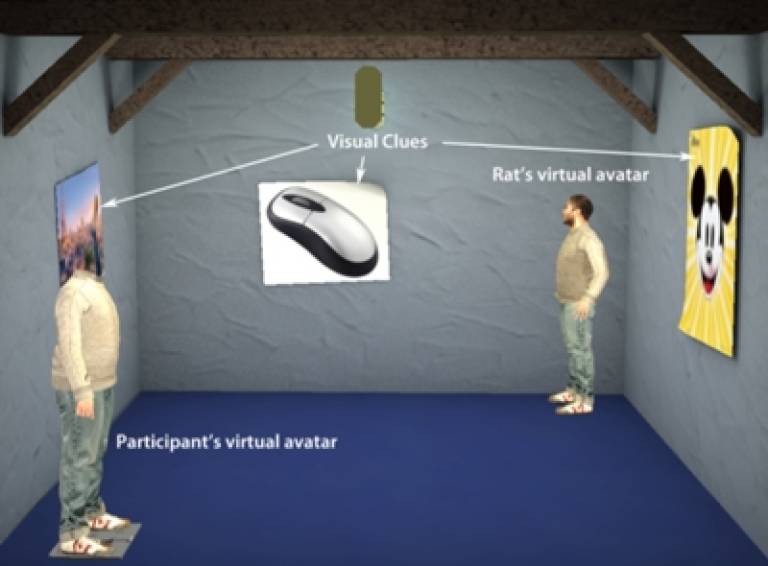Virtual reality 'beaming' technology transforms human-animal interaction
1 November 2012
Using cutting-edge virtual reality technology, researchers have 'beamed' a person into a rat facility allowing the rat and human to interact with each other on the same scale.

Published today in PLOS ONE, the research enables the rat to interact with a rat-sized robot controlled by a human participant in a different location. At the same time, the human participant (who is in a virtual environment) interacts with a human-sized avatar that is controlled by the movements of the distant rat. The authors hope the new technology will be used to study animal behaviour in a completely new way.
Computer scientists at UCL and the University of Barcelona have been working on the idea of 'beaming' for some time now, having last year digitally beamed a scientist in Barcelona to London to be interviewed by a journalist.
The researchers define 'beaming' as digitally transporting a representation of yourself to a distant place, where you can interact with the people there as if you were there. This is achieved through a combination of virtual reality and teleoperator systems. The visitor to the remote place (the destination) is represented there ideally by a physical robot.
During the human-animal beaming process the human participants in the system were in a virtual reality lab at the Mundet campus of the University of Barcelona. The rat was located around 12 km away in an animal care facility in Bellvitge.
The process demonstrated here not only shows the range of our technology, but also provides a new tool for scientists, explorers or others to visit distant and alien places without themselves being placed in any kind of danger, and importantly, to be able to see animal behaviour in a totally new way - as if it were the behaviour of humans.
Professor Mandayam Srinivasan (UCL Computer Science)
Tracking technology was used to track the movements of the rat in its arena, and the tracking data was transmitted over the internet to the computers running the virtual reality simulation in Mundet. This tracking information was used to control a virtual human character (an avatar) that represented the rat so that whenever the rat moved its avatar moved too, in a representation of the rat arena but scaled up to human size. Hence the human participant shared the virtual arena, which looked like a room with some pictures on the walls, with a humanoid avatar.
The movements of the human in the virtual reality were also tracked, and the data sent to computers in Bellvitge that controlled a small robot that was located in the rat arena. Whenever the human moved in the virtual space the robot moved in the rat space.
Putting all this together - the rat interacted with a rat sized robot that represented the remotely located human, and the human interacted with a human sized avatar that represented the remotely located rat.
Professor Mandayam Srinivasan, author of the paper from the UCL Department of Computer Science and MIT, said: "Beaming is a step beyond approaches such as video conferencing which do not give participants the physical sensation of being in the same shared space, and certainly not the physical capability to actually carry out actions in that space."
He added: "The process demonstrated here not only shows the range of our technology, but also provides a new tool for scientists, explorers or others to visit distant and alien places without themselves being placed in any kind of danger, and importantly, to be able to see animal behaviour in a totally new way - as if it were the behaviour of humans."
Professor Mel Slater, also from the UCL Department of Computer Science and also ICREA, University of Barcelona said: "In the paper we used the idea of representing the rat as if it were a human, but there would be many other possibilities. One idea is that using this technology behavioural scientists could get insights into behaviour by observing it, and taking part in it, through this quite different filter. However, our primary goal was to demonstrate the possibilities inherent in this technology."
Image: Virtual reality scene showing the participant's and the rat's virtual avatars.
Media contact: Clare Ryan
Links:
UCL Computer Science
Virtual Environments and Computer Graphics group
 Close
Close

